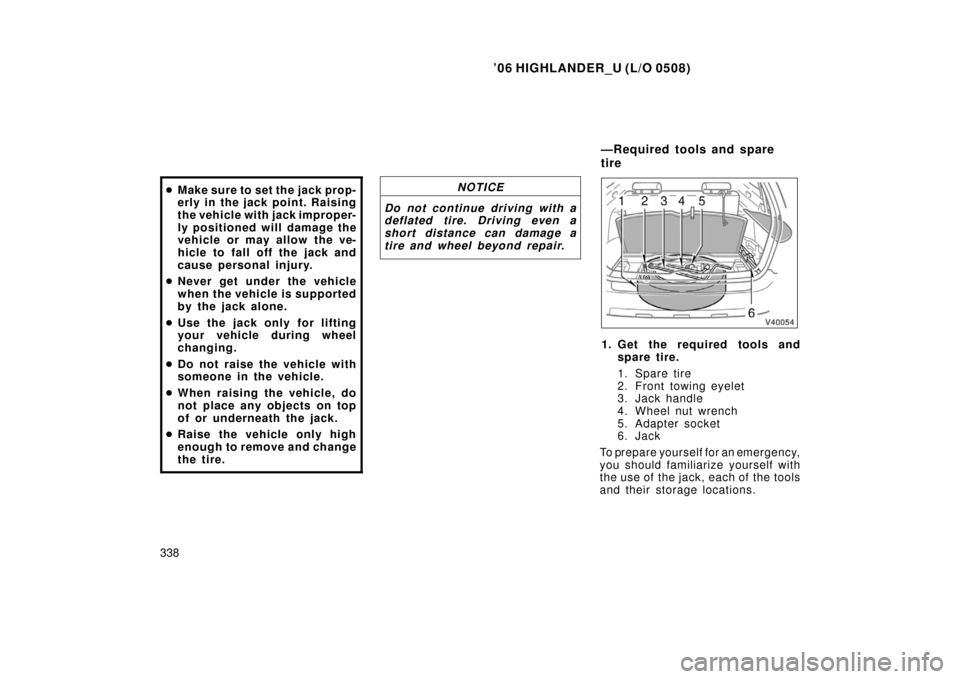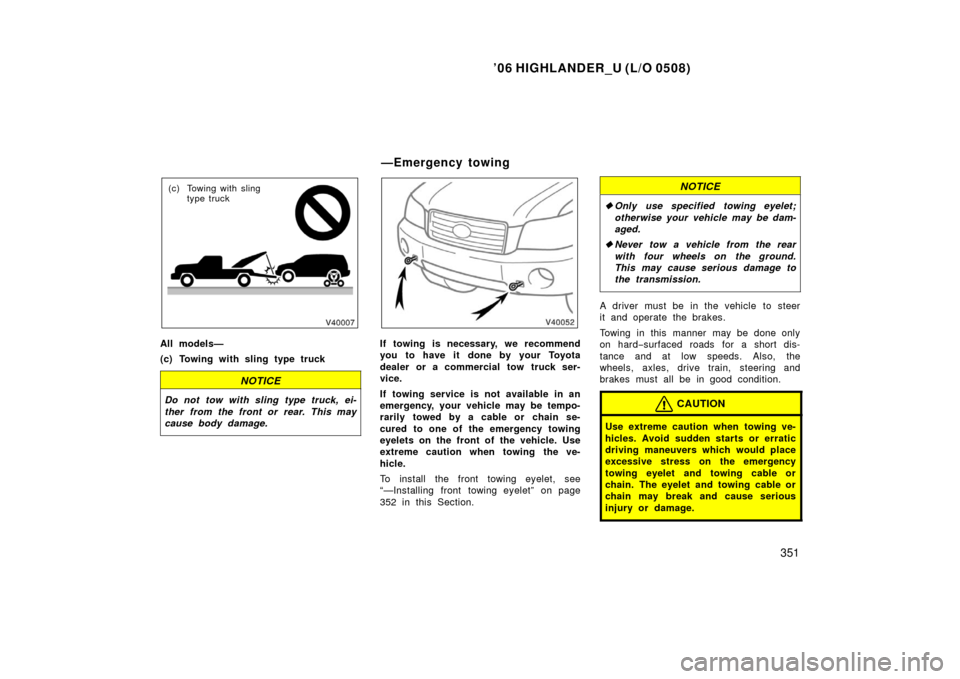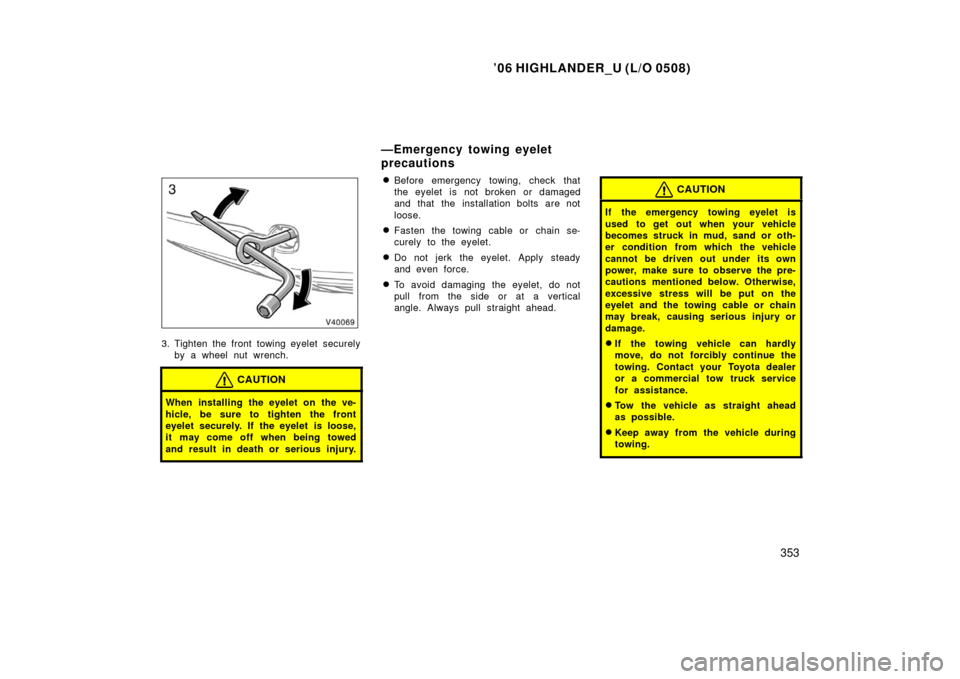Page 348 of 428

’06 HIGHLANDER_U (L/O 0508)
338�
Make sure to set the jack prop-
erly in the jack point. Raising
the vehicle with jack improper-
ly positioned will damage the
vehicle or may allow the ve-
hicle to fall off the jack and
cause personal injury.
� Never get under the vehicle
when the vehicle is supported
by the jack alone.
� Use the jack only for lifting
your vehicle during wheel
changing.
� Do not raise the vehicle with
someone in the vehicle.
� When raising the vehicle, do
not place any objects on top
of or underneath the jack.
� Raise the vehicle only high
enough to remove and change
the tire.
NOTICE
Do not continue driving with a
deflated tire. Driving even a
short distance can damage a
tire and wheel beyond repair.
1. Get the required tools and
spare tire.
1. Spare tire
2. Front towing eyelet
3. Jack handle
4. Wheel nut wrench
5. Adapter socket
6. Jack
To prepare yourself for an emergency,
you should familiarize yourself with
the use of the jack, each of the tools
and their storage locations.
— R eq u ired to o ls an d sp are
tire
Page 360 of 428

’06 HIGHLANDER_U (L/O 0508)
350
If towing is necessary, we recommend
you to have it done by your Toyota
dealer or a commercial tow truck ser-
vice. In consultation with them, have
your vehicle towed using either (a) or
(b).
Only when you cannot receive a towing
service from a Toyota dealer or com-
mercial tow truck service, tow your ve-
hicle carefully in accordance with the
instructions given in “—Emergency tow-
ing” on page 351 in this Section.
Proper equipment will help ensure that
your vehicle is not damaged while being
towed. Commercial operators are generally
aware of the state/provincial and local
laws pertaining to towing.
Your vehicle can be damaged if it is
towed incorrectly. Although most operators
know the correct procedure, it is possible
to make a mistake. To avoid damage to
your vehicle, make sure the following pre-
cautions are observed. If necessary, show
this page to the tow truck driver. TOWING PRECAUTIONS:
Use a safety chain system for all towing,
and abide by the state/provincial and local
laws. The wheels and axle on the ground
must be in good condition. If they are
damaged, use a towing dolly.
Two�wheel drive models—
(a) Towing with wheel lift type truck
From front—
Release the parking brake.
NOTICE
When lifting wheels, take care to en-
sure adequate ground clearance for
towing at the opposite end of the
raised vehicle. Otherwise, the bumper
and/or underbody of the towed vehicle
will be damaged during towing.
From rear—
Use a towing dolly under the front wheels.
NOTICE
Never tow a vehicle from the rear
with the front wheels on the ground,
as this may cause serious damage to
the transmission.
(b) Using flat bed truck
Four�wheel drive models—
(a) Towing with wheel lift type truck
Use a towing dolly under the wheels not
lifted by the truck.
(b) Using flat bed truck
Page 361 of 428

’06 HIGHLANDER_U (L/O 0508)
351
(c) Towing with sling
type truck
All models—
(c) Towing with sling type truck
NOTICE
Do not tow with sling type truck, ei-
ther from the front or rear. This may
cause body damage.
If towing is necessary, we recommend
you to have it done by your Toyota
dealer or a commercial tow truck ser-
vice.
If towing service is not available in an
emergency, your vehicle may be tempo-
rarily towed by a cable or chain se-
cured to one of the emergency towing
eyelets on the front of the vehicle. Use
extreme caution when towing the ve-
hicle.
To install the front towing eyelet, see
“—Installing front towing eyelet” on page
352 in this Section.
NOTICE
�Only use specified towing eyelet;
otherwise your vehicle may be dam-
aged.
� Never tow a vehicle from the rear
with four wheels on the ground.
This may cause serious damage to
the transmission.
A driver must be in the vehicle to steer
it and operate the brakes.
Towing in this manner may be done only
on hard− surfaced roads for a short dis-
tance and at low speeds. Also, the
wheels, axles, drive train, steering and
brakes must all be in good condition.
CAUTION
Use extreme caution when towing ve-
hicles. Avoid sudden starts or erratic
driving maneuvers which would place
excessive stress on the emergency
towing eyelet and towing cable or
chain. The eyelet and towing cable or
chain may break and cause serious
injury or damage.
—Emergency towing
Page 363 of 428

’06 HIGHLANDER_U (L/O 0508)
353
3. Tighten the front towing eyelet securely
by a wheel nut wrench.
CAUTION
When installing the eyelet on the ve-
hicle, be sure to tighten the front
eyelet securely. If the eyelet is loose,
it may come off when being towed
and result in death or serious injury.
�Before emergency towing, check that
the eyelet is not broken or damaged
and that the installation bolts are not
loose.
�Fasten the towing cable or chain se-
curely to the eyelet.
�Do not jerk the eyelet. Apply steady
and even force.
�To avoid damaging the eyelet, do not
pull from the side or at a vertical
angle. Always pull straight ahead.
CAUTION
If the emergency towing eyelet is
used to get out when your vehicle
becomes struck in mud, sand or oth-
er condition from which the vehicle
cannot be driven out under its own
power, make sure to observe the pre-
cautions mentioned below. Otherwise,
excessive stress will be put on the
eyelet and the towing cable or chain
may break, causing serious injury or
damage.
�If the towing vehicle can hardly
move, do not forcibly continue the
towing. Contact your Toyota dealer
or a commercial tow truck service
for assistance.
�Tow the vehicle as straight ahead
as possible.
�Keep away from the vehicle during
towing.
—Emergency towing eyelet
precautions